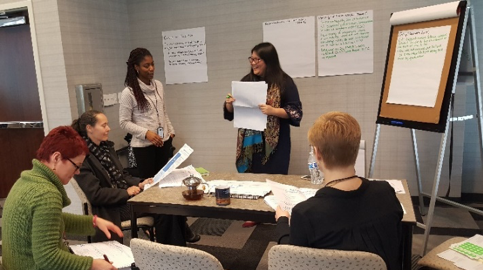Hi! I’m Omoshalewa Bamkole, an Evaluation Fellow in the Division of Scientific Education and Professional Development (DSEPD) in the Center for Surveillance, Epidemiology, and Laboratory Services at the Centers for Disease Control and Prevention.
I recently worked with colleagues to host a data party for internal stakeholders for the first time! What’s a data party? It’s a meeting where stakeholders analyze or interpret data together.
Collaborative data interpretation can result in increased support for the evaluation, more robust stakeholder participation, more meaningful results and useful recommendations. Our event focused on survey data collected from multiple, related programs. Participants worked through these data together to reach a shared understanding of the information and produce actionable recommendations for program improvement.

In our case, a data party fit with the collaborative approach to evaluation already present in DSEPD. So, how did we do it? And, how might you do it, even in less collaborative environments?
Hot Tip 1: Engage participants with purpose
Identify and invite participants purposefully. We invited program, evaluation, and leadership personnel from each program included in the survey. Our invitation explained the event and how they would participate. Be available for questions before the party—this activity is new for many organizations!
Hot Tip 2: Create an environment for maximum participation
Help participants contribute through proper planning and facilitation. We convened a planning group to identify and assign participants to workgroups, develop our agenda and activities, and handle logistics. Make sure to prepare clear, open-ended questions for participants to answer during the event:
- What are these data telling us?
- Is anything missing from the data?
- What is one step we should take based on these data?
During the event, participants reviewed and interpreted data using data placemats, developed findings statements and recommendations for action, and even suggested additional analyses.

Hot Tip 3: Showcase contributions made during the party
Take every opportunity to capture and share participants’ contributions to the data party (and evaluation). After the data party we:
- Posted photos and key findings on electronic bulletin boards.
- Shared findings and recommendations in meetings, newsletters, and reports.
- Presented findings to personnel who were unable to participate in the data party.
Lesson Learned: In DSEPD, I work with other internal evaluators to create a culture of participation in program evaluation. We used a data party to create a meaningful opportunity for stakeholders to contribute to and learn from evaluation activities. Simply put, data parties have the potential to enable meaningful participation by evaluators and non-evaluators alike!
Rad Resources:
Explore Innovation Network’s experiences with participatory analysis and Veena Pankaj’s notes on using data placemats.
Try group learning activities and data games to see what works best in your setting!
The American Evaluation Association is celebrating Internal Evaluation (IE) Topical Interest Group Week. The contributions all this week to aea365 come from our IE TIG members. Do you have questions, concerns, kudos, or content to extend this aea365 contribution? Please add them in the comments section for this post on the aea365 webpage so that we may enrich our community of practice. Would you like to submit an aea365 Tip? Please send a note of interest to aea365@eval.org. aea365 is sponsored by the American Evaluation Association and provides a Tip-a-Day by and for evaluators.
